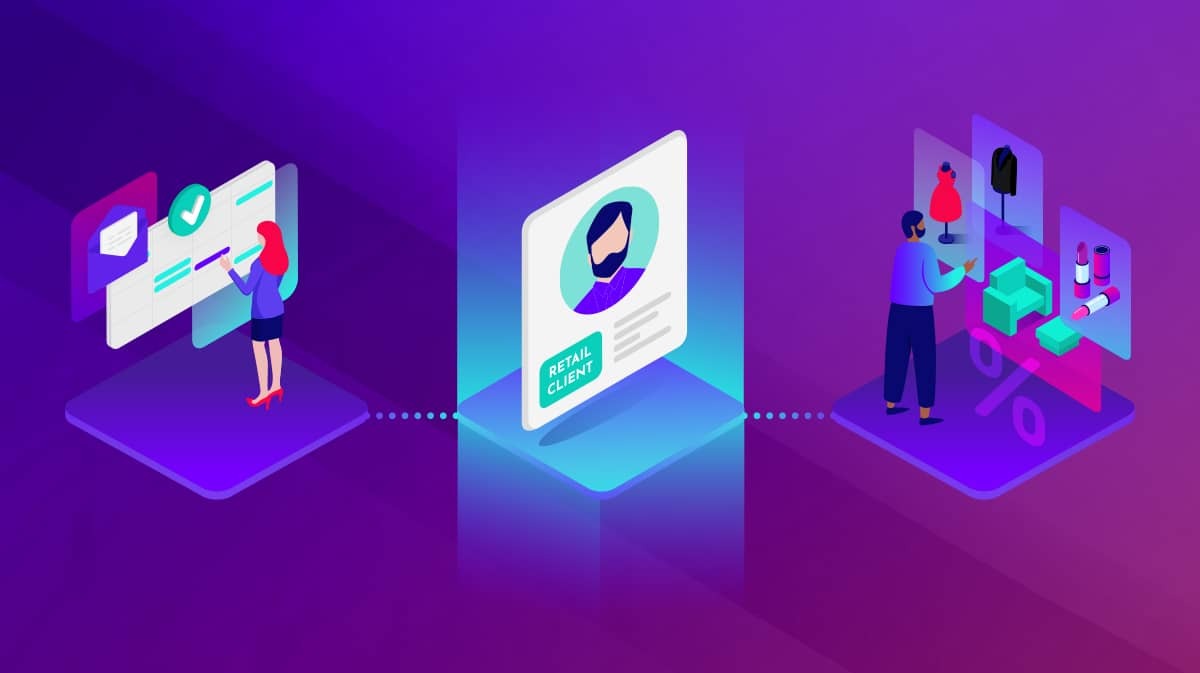Worth the wait: queue management done right
All over the world, businesses are grappling with the novel challenges of operating during a global pandemic. Organizations have long been aware of the benefits of a well-organized queuing system. However, the benefits of reducing time spent waiting in a queue are even more pronounced due to recent events.
For example, the six-foot rule means many customers prefer not to wait in a long queue, in close proximity to others. Accordingly, brick-and-mortar stores are putting measures in place to help maintain that distance and emphasize their commitment to customer health and wellness. These measures include painting circles on the floor, erecting plexiglass barriers, requiring masks, and offering hand sanitizer.
However, not all solutions are physical. Virtual queue management can give customers peace of mind by offering transparent wait times and the control to decide where they wait, and how they choose to social distance. Organized, well-managed queues can reduce customer anxiety, alleviate customer frustration, and create positive brand experiences.
The benefits of well-organized queue management
Over the past few months, online and mobile banking have become more widely adopted with the use of mobile banking, up by 85 percent in the spring. In addition, online retail has understandably surged during lockdown. In both cases, the reopening of physical locations has seen an increase in foot traffic.
It’s likely, however, that customers will be even more impatient about having to wait. So on the one hand, long lines at an establishment suggest desirability and can even increase purchase quantity. On the other hand, people hate feeling like they’re the last in line, and a visibly long line can deter customers altogether, while generating concerns about overall health and safety.
With this in mind, retailers and banks can use optimized queuing systems to improve their businesses in four key areas.
1. Safety
In these days of COVID-19, a store or bank’s clear adherence to CDC guidelines for health and social distancing goes a long way toward reassuring customers and ensuring repeat business. For example, virtual queues allow customers to avoid physically lining up at all. This frees them to browse the store or even wait outside or in their cars until they can be seen.
A recent survey of 2,000 banking customers conducted by Shikatani Lacroix showed that 45.6 percent of respondents would welcome a mobile feature for customers to book appointments. Similarly, 44.1 percent thought banks should implement a system allowing customers to queue via mobile app rather than in the branch. In other words, these banking customers were hoping for virtual queuing and appointment scheduling.
2. Customer experience
While safety is currently an especially crucial part of making customers feel welcome, the psychology of queuing has some fascinating effects on the overall customer experience. While it sounds dramatic, research from the Northridge Group suggests 72 percent of customers are tempted to switch companies after only one negative service experience. Additionally, our own research on consumer banking suggests that 44 percent of consumers who visit their bank’s branches reported that a long wait in line was the primary reason for their dissatisfaction with the experience.
All this suggests that waiting in line (whether for a service or to make a purchase) has a significant effect on customers’ overall perceptions of a brand. In part, this is because waiting is a static and solitary experience, one that can leave customers feeling ignored.
Optimized queue management systems help improve customer flow, reduce or even eliminate lines, and allow staff to focus on customer service.
3. Revenue impact
Queues are not inherently problematic. In fact, sometimes a longer wait gives customers time to add things to their basket and even induces larger customer purchases. As researchers from the McDonough School of Business at Georgetown University note, “This is driven by mental accounting: A larger purchase allows people to offset the fixed cost of the long wait.”
This same research project suggests that offering customers interesting diversions (such as informational displays or reading material) can improve the queuing experience and keep people from abandoning their purchase and the establishment. The key seems to be clarity. If customers understand why they must wait and can make a reasonable estimate of how long the wait will be, they’re more likely to be patient. Inexplicably long lines (or a sense that the order in which people are seen is unfair) quickly erode customer goodwill.
4. Operational efficiency
A well-managed queue has a positive impact not only on customer experience and revenue but also on operational efficiency. The right queue management system offers valuable and actionable data, such as
- average wait times,
- relative traffic on different days and times, and
- variable wait times for different services.
These metrics can guide staffing decisions, opening hours, and service lines. Sophisticated queue management systems should also allow a company to test different types of queues to learn which work best for their specific needs.
Waiting times—perception and reality
Thirty-seven billion hours—that is the approximate amount of time Americans spend waiting in lines every year. The actual time spent in lines is not really the problem, though. MIT professor Dr. Richard Larson, one of the world’s foremost experts on queuing theory, told the New York Times that people typically overestimate how long they’ve waited in a line by about 36 percent. This means that the actual wait time, no matter how brief or well managed, is not the issue. The real issue is perceived wait times - how long people feel like they are waiting.
Equally importantly, research from Columbia Business School shows that the number of people in line affects customer behavior more dramatically than how quickly the line moves. Customers seem to prefer more lines with fewer people in each line than one long line that feeds into multiple tellers or cashiers, even if the latter is in fact the more efficient system.
Thus, the optimal solution is a system that reduces both the perception and the reality of wait times.
Six ways to reduce queue waiting times
The question is therefore this: How do businesses ensure their queues are both organized and effective? These six queue management strategies can help to shorten wait times (both actual and perceived) and improve the customer experience.
1. Implement a queue management system with both in-location and virtual queue options.
Choosing and implementing a queue management system is an ideal first step. That’s because these systems enable a retailer or bank to collect the data they need to drive beneficial immediate and longer-term decisions.
For example, a good queue management system can help customers by facilitating self-service through a real-time concierge interface. Simultaneously, it can help staff by managing customers’ arrival times and allowing staff to focus on providing the best-possible service during their in-person interactions with customers.
2. Be transparent and keep customers informed.
Customers mind waiting more when they don’t know how long their wait will last. For instance, a bank client may come into a local branch on her lunch hour, hoping to get in and out and head back to work. If she comes in and there are other people in line ahead of her, she might try to guess how long her wait will be, and that guess will affect her decision to stay or go.
In contrast, if she knows she will get service before her lunch hour is over, she is much more likely to stay. Banks can avoid wait time uncertainty by making wait times public. A clearly visible display board showing approximate wait times helps keep customers informed. It also helps prevent customers from possibly misjudging a long line and leaving.
When using virtual queues, businesses should also proactively notify customers of their place in line. If customers have to continue checking their wait time themselves, the virtual option may cause just as much tension as waiting in person. But if they receive convenient notifications that they are “moving up” in line, they are less likely to become frustrated.
3. Offer appointment scheduling.
Another excellent way to reduce customer uncertainty in relation to wait times is to offer appointment scheduling. Open-access scheduling, also known as advanced-access or same-day scheduling, allows customers to choose the time that best works for them. This means that when a customer arrives, they can immediately get the service they need.
This advance scheduling also gives staff members the opportunity to prepare for the customer’s visit. They can look at the information they have about the customer and be ready with personalized service as soon as the customer arrives.
4. Speed up service time.
Overall, staff members can much more quickly and effectively serve a client if they are at least somewhat familiar with the person they are helping. Virtual queues and hybrid queues help provide staff with relevant information while also keeping clients engaged.
With these types of queues, customers can begin their wait by checking in via a digital system and filling in key information, such as their name and details about their orders or services. Initially, this keeps them busy and minimizes their perceived wait time.
It also gives the staff relevant information about the customer so they can be prepared to assist them. The end result is faster service and improved customer satisfaction.
5. Use queue data to optimize staffing and pinpoint staff training needs.
The information that queue management systems provide can let managers know what kinds of problems are taking the longest to solve. It also helps managers know if staff are adequately trained to handle such problems.
If a staff member is taking noticeably longer (or noticeably shorter) to serve customers, managers can identify why that is. This can be an opportunity to improve training and also evaluate the success of overall training procedures.
6. Provide entertainment or education while customers wait.
Not all businesses can provide musical water fountains or jewel-mining games like vacationers get while waiting for the Seven Dwarfs Mine Train at Disney World. All businesses can, however, make sure their customers have things to do and look at while they are waiting.
Wait times are an opportunity to engage patrons. For instance, companies can offer digital signage and video displays of new products or upcoming promotions. Banks can offer screens that cycle through financial tips, promotions for specific banking services and products, and information about the bank’s core mission and areas of expertise.
Another way to keep customers engaged is through the use of surveys or fun quizzes. There are two benefits of such interactive activities: (1) they give customers something to do with their wait time while (2) also providing valuable customer feedback.
Queue management is the key to reduce waiting times
Queues can be complicated to manage. However, when done right, they will not only fulfill customers’ needs but also benefit banks and retail stores in both short-term and long-term ways. By considering ways to reduce waiting times, businesses embrace the potential for improved customer service experiences, increased brand loyalty, and greater overall efficiency.
For more information on ways to improve queues, reach out to a JRNI expert. We can help you choose and implement the best queue management solutions for your business.




